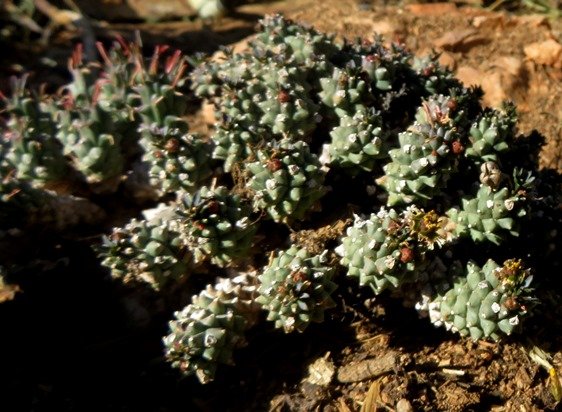Euphorbia ramiglans now E. caput-medusae

Author: Ivan Lätti
Photographer: Thabo Maphisa
Euphorbia ramiglans is a dwarf stem succulent, a form of E. caput-medusae into which it now has been absorbed. So have E. tuberculata, E. muirii and E. marlothiana, all growing near some part the west coast of South Africa and bearing cyathia hard to differentiate from each other. That task is fortunately no longer necessary, while the observed variations can be enjoyed.
E. ramiglans used to be associated with the sandy, coastal strip of land north of Port Nolloth. Part of the Richtersveld, the plant's distribution continues to Alexander Bay and the Gariep River, also 60 km further into Namibia. The particular conditions prevailing in this far northwesterly part of the country brought a different appearance to these E. caput-medusae plants, initially not recognised as the well-known, more southerly species. Separate species identities may appear or disappear as knowledge increases, sometimes aided by newer technologies such as comparing DNA.
The flat, sandy, western part of the Richtersveld receives its little rain in winter. Some years it gets nearly none at all. Heavy, low fog that lingers does compensate somewhat, as well as the lower temperatures occurring here compared to the inland across the mountains to the east. Many succulent plants do well in these climatic conditions, including this Euphorbia.
The main, short stem is club-shaped, becoming 5 cm thick. It is based on ample, fleshy roots. The numerous branches angle up and out from the upper stem part, 2,5 cm to 4 cm long and 12 mm to 20 mm thick.
Some plants are described as single-stemmed, their branching beginning several centimetres above-ground. Those stems may be sand-blasted on the side of the prevailing wind. This wind also moves the sand, discomfiting the plant by uncovering an upper part normally concealed. Conversely, close to the sea some of the plants are semi-buried in the sand, at times only the purple fruit capsules seen dotted on long stalks in a cluster above the sand.
The survival tactics of living species are more inventive and wide-ranging than the tricks of circus magicians, although spectators don't feature in the design of such exercise if they are not pollinators or fruit dispersers (Frandsen, 2017; Williamson, 2010; iNaturalist; http://redlist.sanbi.org).

